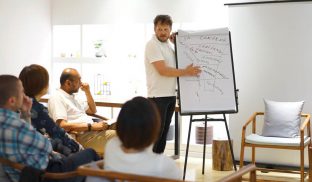We put so much time into workshop prep. We create customized outlines, get to know a client’s goals, then work hard to design approaches that will help them realize their vision.
But when crunch time rolls around, we only have a few days to get people on board and ready to grow. So how can we build relationships that really enable progress? Here are some warm-ups which never fail to get people engaged.
Why Relationships Matter
Whether it’s at the team or organizational level, our systems are human. And to really ‘bring the context in the room’, we need to come at things with a human-centered perspective. No growth intervention is just about content, so we need relationships to make things work.
So we stand to gain a lot from teambuilding, though the specific ‘Whys’ will depend on your shared vision. Do you want to improve the use of your collective skills? Are you hoping to defragment silos and collaborate better? Or are you coming together for the very first time, hoping to succeed in a new context?
Whichever it is, you’ll find it works better when people trust each other. Based on our facilitation experience, even a small amount of time spent building relationships at the start of an intervention can have huge payoffs.
These exercises, among others, enable us to maximize the short periods we have together at the start of a workshop. They help us establish a playing field and a safe, supportive space for sharing ideas.
1. The ‘Speed Date’ Walk
Why: Build team integration
How: Short, one-on-one dialogue and ideally, positive questions.
What You’ll Need: Somewhere (nice!) to walk outdoors, up to 15 participants, and 90 minutes of time (at least 6 minutes for each ‘date’).
1. Start by creating a list of questions. These should be open-ended to encourage rich descriptive answers or even stories. Try to create questions that encourage a positive atmosphere and also, develop as many as possible so team members can explore many different angles together. For example:
– Recall any significant day in your life, between 5 and 10 years ago. Could you describe that day to me?
– What are some of the most important lessons you learned from your parents?
– What other company, besides this one, would you love to work for. Why?
2. Invite participants to find a walking partner. Encourage them to choose someone they haven’t worked with before.
3. While you walk, one person starts by asking a question. Their conversation partner has the full three minutes to answer before they swap.
4. After six minutes, it’s time to switch ‘date’ partners. Continue until everyone has met everybody else.
To make this activity more relevant to the organization’s growth objective, design questions that relate in some way to the topic. Drawing on Appreciative Inquiry principles, these might focus on your organization’s core strengths, like “Could you describe the most recent big success you’ve had as part of a team?” or “Tell me about what your key competitor does really well, and why it works?”
2. Screenwriters Collaborate!
Why: Joint decision-making, communication
How: Collaborating creatively
What You’ll Need: A large group of participants, drawing materials, and paper.
1. Split the group into sub-teams of 3-6 people. Each group will be working collaboratively on a short play that they will eventually bring to life.
2. Within each group, participants will need to decide the plot for their play and work together to develop the script. Together, they will come up with the shared idea for a plot, but they will then split off to write one scene each. Make sure there are as many characters in the play as there are participants!
3. Because they won’t be working together on their respective scenes, they will need to focus their efforts on developing a shared understanding of how things will flow, who will do what, and the content for each scene. What are the characters’ personalities? How do they develop as the story unfolds? What atmosphere do we want to create with the play?
4. At the end of the exercise, groups perform their plays together. It’s a nice way to stimulate both analytical and holistic thinking, while they step into their stretch zones!
3. What We Share
Why: Relationship building
How: Active listening and identifying similarities on a human level
What You’ll Need: An even number of participants.
1. Invite participants to break off into pairs
2. In each pair, and over three minutes, one partner describes a successful team project that they have really enjoyed. For example, they can describe what worked well, what they feel contributed to that success, or how the team overcame an obstacle. The other will listen attentively without taking notes or asking questions.
3. After three minutes, it is the listener’s turn to talk, and they will then come up with important things that they share with their partner. The goal is to use what the speaker has said to identify as many things as possible that they have in common, for example:
– “Seems like we both value quality over speed in our work.”
– “It sounds like task clarity matters as much to you as it does to me”; or
– “I also prefer working in a small group of people.”
Have you been part of any team warm-up exercises that you’d like to share? Let me know at our Time To Grow Global LinkedIn, or head here to find out more about our workshop facilitation interventions.

Govert is Time To Grow Global’s Managing Partner, specializing in Strategy Facilitation, Leadership development and Organisational performance. Reach him on our Time To Grow Global LinkedIn.


